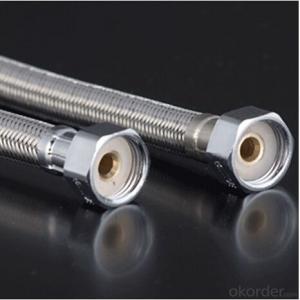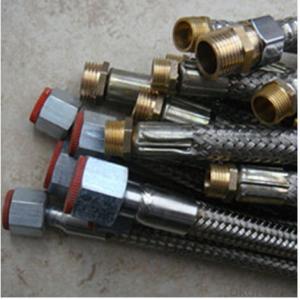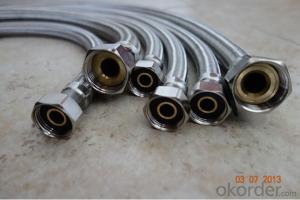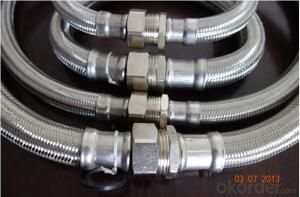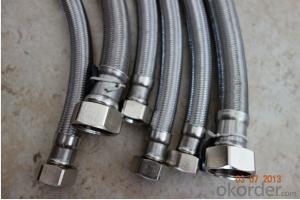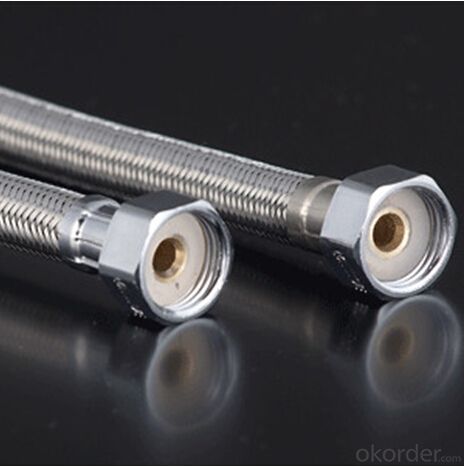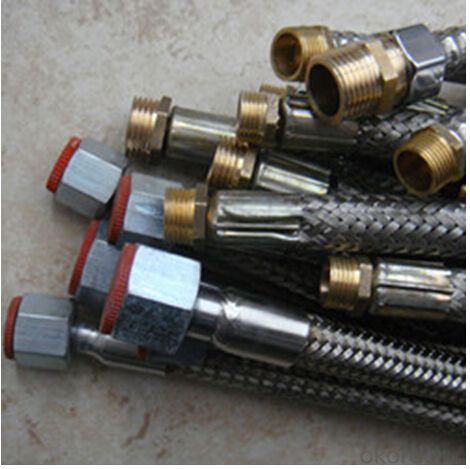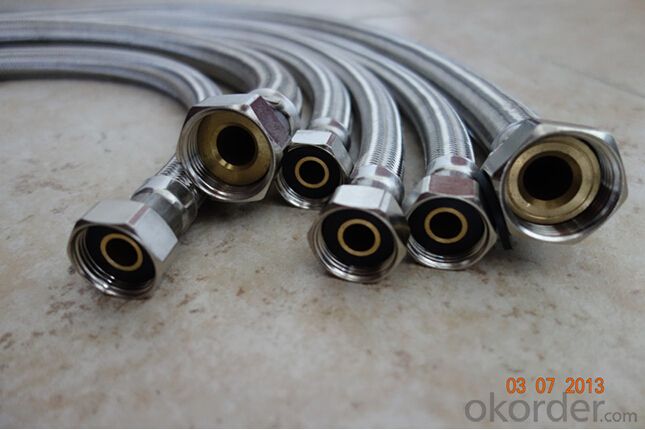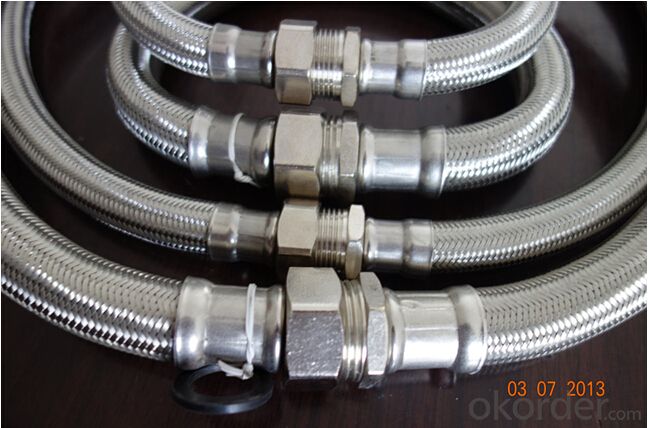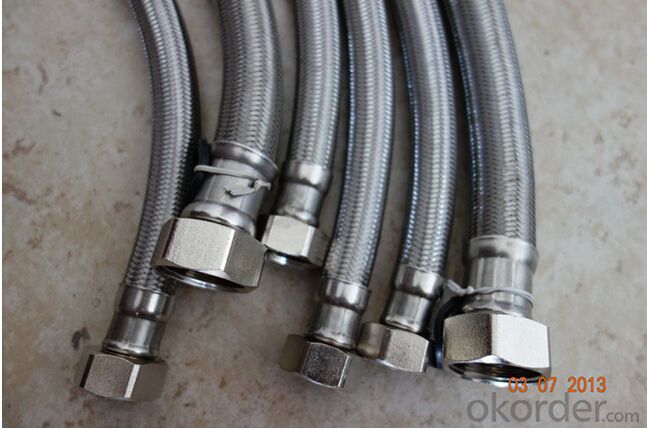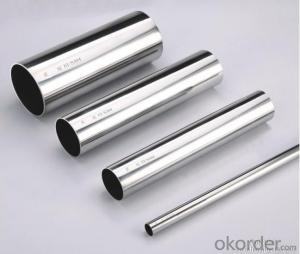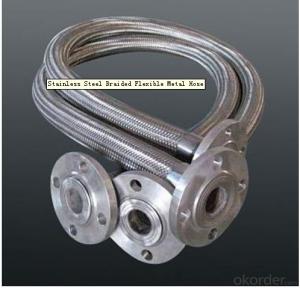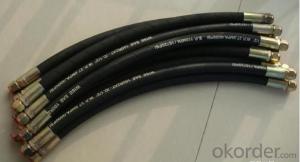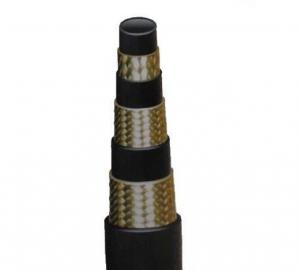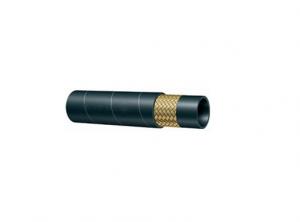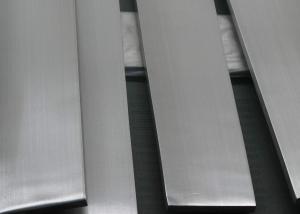Stainless Steel Braid Hose with High Pressure Corrugated
- Loading Port:
- Tianjin
- Payment Terms:
- TT OR LC
- Min Order Qty:
- 1000 pc
- Supply Capability:
- 100000 pc/month
OKorder Service Pledge
OKorder Financial Service
You Might Also Like
Specification
Stainless Steel Braid Hose with High Pressure Corrugated
Applications of Stainless Steel Braid Hose with High Pressure Corrugated:
--Refueling system
--Chemical and pharmaceutical industry
--Industrial hydraulic systems
--Air conditioners in industrial and construction –site vehicles
--Food and beverage industry
--Special and standard industrial applications
--Water and cleaning management
Features of Stainless Steel Braid Hose with High Pressure Corrugated:
1. )O. D.: 13-18MM 0.2-3M long
2. )Nut.: Nickel/Chrome Plated Brass (Zinc / Iron / Aluminum is available)
3. )Size Of Nut.: Female&Male 1/2''; 3/4''; 3/8''; 7/8''; 5/16'', and M10...
4. )Insert.: Brass (Zinc / Aluminum / Plastic is available)
5. )Inner tube.: Rubber/ EPDM/PVC
6. )Covered Material: Stainless Steel 201, 301, 304 /Aluminium Wire
7. )Working Pressure: 5Kg-15Kg
8. )Temperature: 0-92° C
9. )Quality Assurance: 3 years
RemarkAPPLICATION: HOUSEEHOLD WARE, BATHROOM WARE, SHOWER HOSE
PAYMENT: T/T, L/C
DELIVERY TIME: 20DAYS OR 30DAYS AFTER RECEIVED 30% DEPOSITS
MOQ: 5000PCS
ODM&OEM IS ACCEPTABLE
PackageInner: PP bag /Blister packing Outer: Carton box
Specifications of Stainless Steel Braid Hose with High Pressure Corrugated:
NO | I.D | Refer to O.D | Working pressure | Burst pressure | approximate Weight | |||||
(inch) | (mm) | (inch) | (mm) | MPa | Psi | MPa | Psi | kg/m | lbs/ft | |
1 | 1/8 | 3.2±0.2 | 0.35 | 9±0.3 | 2.06 | 300 | 8.27 | 1200 | 0.078 | 0.12 |
2 | 5/32 | 4±0.2 | 0.4 | 10±0.3 | 2.06 | 300 | 8.27 | 1200 | 0.092 | 0.14 |
3 | 3/16 | 4.8±0.2 | 0.43 | 11±0.3 | 2.06 | 300 | 8.27 | 1200 | 0.108 | 0.16 |
4 | 1/4 | 6.3±0.3 | 0.5 | 12.7±0.3 | 2.06 | 300 | 8.27 | 1200 | 0.134 | 0.2 |
5 | 5/16 | 8.0±0.3 | 0.56 | 14±0.3 | 2.06 | 300 | 8.27 | 1200 | 0.147 | 0.22 |
6 | 3/8 | 9.5±0.3 | 0.63 | 16±0.4 | 2.06 | 300 | 8.27 | 1200 | 0.182 | 0.27 |
7 | 15/32 | 12±0.3 | 0.75 | 19±0.5 | 2.06 | 300 | 8.27 | 1200 | 0.238 | 0.35 |
8 | 1/2 | 12.7±0.4 | 0.78 | 20±0.5 | 2.06 | 300 | 8.27 | 1200 | 0.262 | 0.39 |
9 | 5/8 | 16±0.4 | 0.94 | 24±0.5 | 1.03 | 150 | 4.12 | 600 | 0.351 | 0.52 |
10 | 3/4 | 19±0.4 | 1.13 | 28.8±0.5 | 1.03 | 150 | 4.12 | 600 | 0.515 | 0.77 |
11 | 1 | 25.4±0.5 | 1.38 | 35±0.6 | 1.03 | 150 | 4.12 | 600 | 0.637 | 0.95 |
Images of Stainless Steel Braid Hose with High Pressure Corrugated:
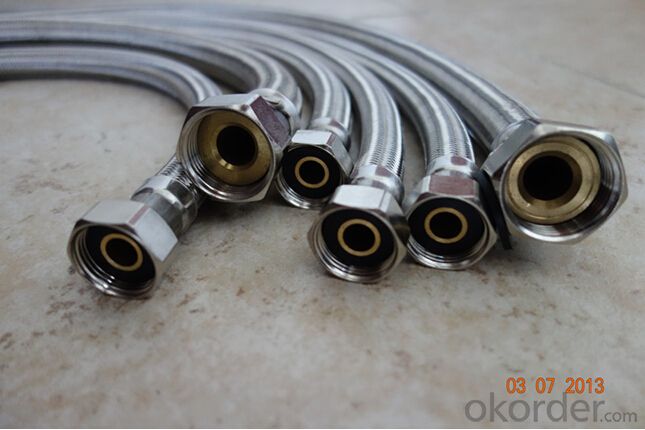
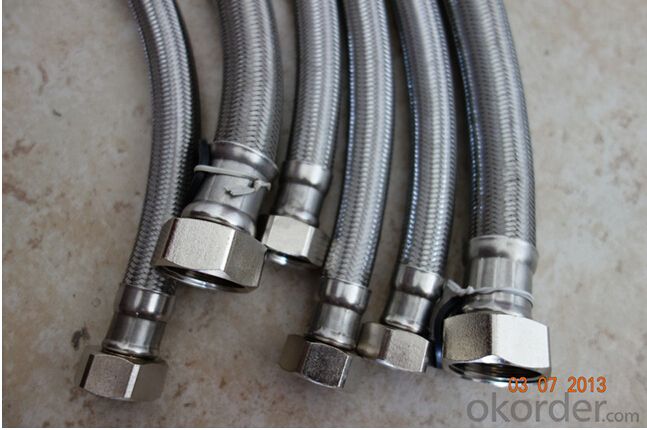
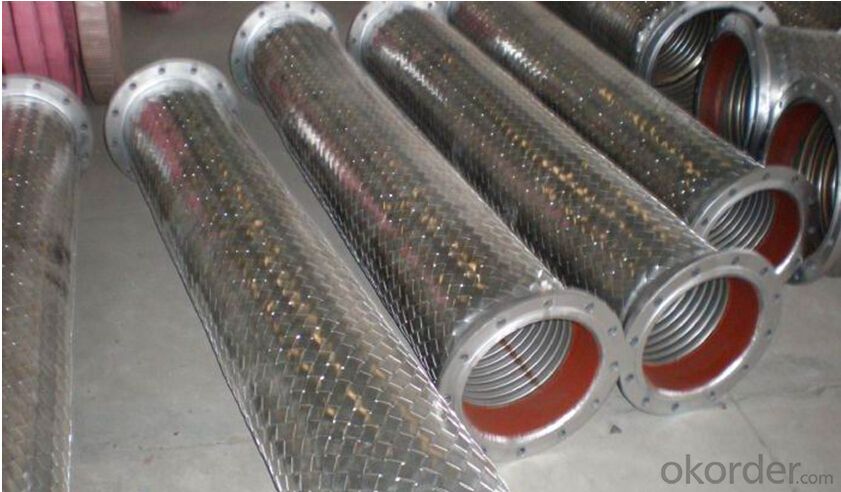
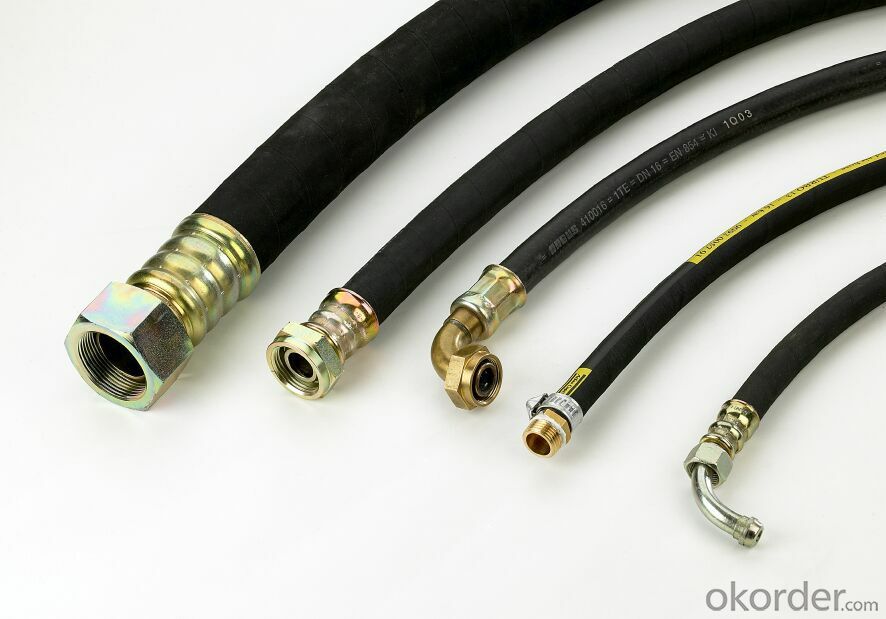
Package of Stainless Steel Braid Hose with High Pressure Corrugated:
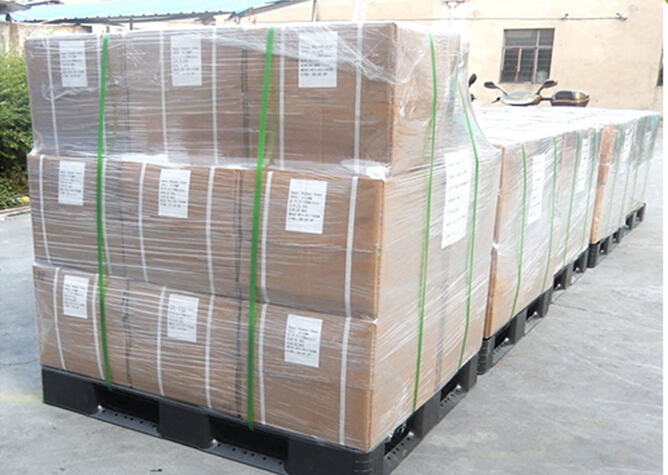

FAQ of Stainless Steel Braid Hose with High Pressure Corrugated:
Who we are:
Answer: We CNBM is a Chinese state-owned enterprise ranked 267th among the Global Fortune 500, as the largest building materials company,we have over 300 affiliated companies,and so many production lines and branch office distribute in China.
2. About our quality:
Answer: Every product needs to be quality proved before shipping.
3. About our service:
Answer: We could gurantte that we can reply you in 2 working hours.
- Q: Can stainless steel pipes be used in power plants?
- Yes, stainless steel pipes can be used in power plants. Stainless steel is highly resistant to corrosion, making it suitable for various applications in power plants where there may be exposure to high temperatures, pressures, and corrosive environments. Stainless steel pipes are commonly used for transporting fluids such as water, steam, and chemicals in power plants. They are also used in various components such as heat exchangers, boilers, condensers, and turbines. The durability, strength, and resistance to corrosion of stainless steel make it a reliable choice for power plant applications.
- Q: Can stainless steel pipes be annealed?
- Stainless steel pipes possess the capability to undergo annealing, a process involving the heating of these pipes to a specific temperature, followed by a gradual cooling, which effectively alleviates stress, enhances ductility, and improves the mechanical properties of the material. Throughout the annealing process, the stainless steel pipes are heated to a temperature surpassing their recrystallization point, typically ranging from 1040°C to 1120°C (1904°F to 2048°F) for austenitic stainless steels. Consequently, this permits the internal structure of the pipes to achieve greater uniformity, thus relieving any stresses that may have been incurred during manufacturing or prior usage. Subsequently, post-annealing, the stainless steel pipes will exhibit improved formability, heightened toughness, and reduced hardness, rendering them suitable for a diverse range of applications across industries such as oil and gas, chemical processing, and construction.
- Q: Can stainless steel pipes be insulated with asbestos?
- No, stainless steel pipes should not be insulated with asbestos. Asbestos is a hazardous material that has been linked to serious health risks, including lung cancer and mesothelioma. It is widely recognized that exposure to asbestos fibers can be extremely dangerous, and its use has been banned in many countries. There are several alternative insulation materials available that are safer and more effective than asbestos. These include fiberglass, mineral wool, and foam insulation. These materials provide excellent thermal insulation properties without posing the same health risks as asbestos. When insulating stainless steel pipes, it is important to consider the specific requirements of the application and choose an appropriate insulation material that meets the necessary safety standards. It is always advisable to consult with a professional insulation contractor or engineer to ensure the correct insulation material is selected.
- Q: Are stainless steel pipes suitable for high-temperature steam?
- Yes, stainless steel pipes are suitable for high-temperature steam. Stainless steel has excellent heat resistance properties, making it a reliable choice for conveying steam at high temperatures. It can withstand the high-pressure and high-temperature conditions associated with steam systems, ensuring durability, safety, and efficient operation.
- Q: What is the difference between 304J6 and 316J6 stainless steel pipes?
- The main difference between 304J6 and 316J6 stainless steel pipes lies in their composition and corrosion resistance. While both alloys contain chromium and nickel, 316J6 stainless steel pipes have a higher percentage of molybdenum, which enhances their resistance to corrosion, specifically in environments with chlorides or other harsh chemicals. This makes 316J6 stainless steel pipes more suitable for applications in marine environments or industries where corrosion resistance is crucial.
- Q: Are stainless steel pipes resistant to sea water corrosion?
- Indeed, the resistance of stainless steel pipes to corrosion caused by sea water is highly remarkable. The exceptional corrosion resistance of stainless steel is widely recognized, which makes it an optimal material for various applications, including pipes utilized in marine settings. The presence of elevated levels of chromium and nickel in stainless steel results in the formation of a protective layer on the metal's surface, effectively preventing corrosion and damage caused by exposure to sea water. Moreover, stainless steel pipes also exhibit resistance against other forms of corrosion, such as rusting and pitting, thereby further augmenting their durability and longevity in marine environments. Consequently, stainless steel pipes prove to be a dependable option for applications involving contact with sea water.
- Q: Can stainless steel pipes be used for semiconductor manufacturing?
- Indeed, stainless steel pipes have the capability to be utilized in the realm of semiconductor manufacturing. The rationale behind this lies in the fact that stainless steel possesses exceptional resistance to corrosion, can withstand high temperatures, and exhibits mechanical strength. Due to these attributes, stainless steel pipes become well-suited for an array of applications within the semiconductor industry, including gas and chemical delivery systems, vacuum systems, and high-purity water distribution. The procedures involved in semiconductor manufacturing necessitate the transportation of diverse gases, chemicals, and liquids, and stainless steel pipes prove to be reliable and capable of maintaining purity throughout this process. The corrosion resistance of stainless steel guarantees that the pipes will not contaminate the semiconductor materials or the manufacturing process. Furthermore, stainless steel pipes can endure the high temperatures inherent in semiconductor manufacturing without compromising their structural integrity. Additionally, stainless steel pipes can be manufactured to meet the stringent cleanliness requirements of the semiconductor industry. They can undergo electropolishing or passivation to eliminate surface impurities and contaminants, further enhancing their suitability for utilization in semiconductor manufacturing. In summary, stainless steel pipes present a durable, corrosion-resistant, and high-purity solution for semiconductor manufacturing applications, which renders them a favored choice in the industry.
- Q: Can stainless steel pipes be used for chemical processing plants?
- Yes, stainless steel pipes can be used for chemical processing plants. Stainless steel is highly resistant to corrosion and can withstand the harsh chemicals and high temperatures often found in chemical processing plants. It also maintains its strength and durability over time, making it a suitable choice for transporting and storing various chemicals in such facilities.
- Q: Can stainless steel pipes be used in harsh environments?
- Yes, stainless steel pipes can be used in harsh environments. Stainless steel is highly resistant to corrosion, making it an ideal choice for environments that are exposed to harsh conditions such as high temperatures, chemicals, and moisture. It is commonly used in industries such as oil and gas, chemical processing, marine, and wastewater treatment, where the pipes are subjected to extreme conditions and need to withstand corrosion and erosion. Additionally, stainless steel pipes have excellent strength and durability, making them suitable for environments with high pressure or mechanical stress. Overall, stainless steel pipes are a reliable and long-lasting option for use in harsh environments.
- Q: How are stainless steel pipes different from carbon steel pipes?
- Stainless steel pipes and carbon steel pipes exhibit various dissimilarities encompassing their composition, corrosion resistance, and cost. To begin with, the composition of stainless steel pipes encompasses a notable amount of chromium, which imparts them with their distinctive corrosion resistance. Conversely, carbon steel pipes primarily consist of iron and carbon, devoid of any significant alloying elements. This divergence in composition endows stainless steel pipes with enhanced resistance against corrosion, oxidation, and the formation of rust when exposed to diverse environmental conditions or fluids. Additionally, stainless steel pipes possess exceptional strength and durability attributed to their alloying elements, such as nickel and molybdenum, which augment their mechanical properties. In contrast, carbon steel pipes, while sturdy, do not possess the same level of strength and durability as stainless steel pipes. Furthermore, stainless steel pipes exhibit high resistance to heat, rendering them suitable for applications involving elevated temperatures or extreme heat conditions. On the other hand, carbon steel pipes, albeit having satisfactory heat resistance, may not be as effective as stainless steel pipes in such applications. Lastly, the cost aspect plays a notable role in distinguishing stainless steel pipes from carbon steel pipes. Generally, stainless steel pipes are more costly than carbon steel pipes due to the elevated production expenses associated with their alloying elements and corrosion-resistant properties. In summary, stainless steel pipes diverge from carbon steel pipes in terms of their composition, corrosion resistance, strength, heat resistance, and cost. Stainless steel pipes offer superior corrosion resistance, heightened strength, and improved heat resistance, rendering them ideal for applications in corrosive environments or high-temperature conditions. However, they come at a higher cost compared to carbon steel pipes, which continue to be widely used in various industries due to their affordability and moderate mechanical properties.
Send your message to us
Stainless Steel Braid Hose with High Pressure Corrugated
- Loading Port:
- Tianjin
- Payment Terms:
- TT OR LC
- Min Order Qty:
- 1000 pc
- Supply Capability:
- 100000 pc/month
OKorder Service Pledge
OKorder Financial Service
Similar products
Hot products
Hot Searches
Related keywords
